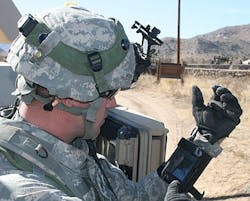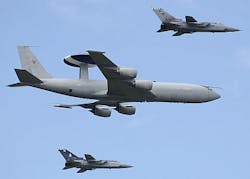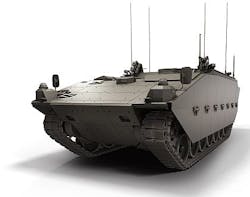Rugged smartphones blend with information security, anti-tamper for secure battlefield communications
Editor's note: GE Intelligent Platforms changed its name to Abaco Systems on 23 Nov. 2015 as a result of the company's acquisition last September by New York-based private equity firm Veritas Capital.
SPECIAL REPORT, 2 April 2012.Rugged smartphone technology is joining forces with information security, anti-tamper technology, and secure cloud computing to create manageable battlefield communications infrastructure that is more effective than ever before.
It’s tough to get information out to the front lines, even in today’s heavily networked battlefield. With so much important information flying around on networks it is still the people who need it most that are the ones who are the hardest to reach. Fortunately, the solution to these information woes just may be sitting on the shelves of the local Best-Buy.
Smart phones are ubiquitous in today’s society. Everyone from business people to teenagers has them and knows what they can do. They link people to whatever commercial carrier network they choose and give unprecedented functionality in a small package. For these reasons militaries around the world are looking into putting secure cell phone technology into the hands of soldiers on the front lines.
Still, distributing military cell phones is far more complicated than simply making a trip to the electronics store. Before deploying cell phones to warfighters, military authorities must ensure that cell phones that may carry classified or sensitive information have appropriate security so the enemy cannot steal valuable information or inject false information into the networks. Anti-tamper capability also must be involved so a lost cell phone does not give away its secrets.
For those on the front lines, however, the extra effort necessary to introduce cell phones to the battlefield will be worth it. While a cumbersome laptop or a difficult-to-store tablet computer might hinder a warfighter on the battlefield, a secure cell phone may enable a soldier not only to enhance his mobility, but also helping the soldier obtain and share crucial information over military networks.
Security
Equipping soldiers with cell phones that operate on military networks and store data requires a secure way for the devices to communicate and a way to render them useless should they be lost or captured. The U.S. military still is hotly debating what security standards will be necessary.
Bill Guyan, vice president of programs and strategy for DRS Tactical Systems Inc. in Melbourne, Fla., explains the security situation. “There was a time about a year and a half ago when the answer to encryption was yes, that type 1 encryption would be the mandatory battlefield standard for all communications. Since then, for a lot of different reasons -- some of it being clarification of policy regarding the security of data on the battlefield and the drive to rapidly get new technology to the field faster -- a number of different alternate approaches have come to the floor.
“The near-term requirements for handhelds, the requirements that we're expecting to happen in the middle of this year, is for smart phone technology with no security whatsoever," Guyan continues. "The smart phone will connect to one or more types of radios, some of which might have security capabilities.”
Official military cell phone guidelines still are in the works, however, and many different groups are scrambling to produce a standard that will protect military communications and still allow for fast communication times. "The NSA is working directly and openly with industry to work out what the parameters of the secure interface will be," says David Howgill, product manager of the Government Solutions Group at TeleCommunication Systems Inc. (TCS) in Annapolis, Md. "There will be standards coming in the near future that will be developed between industry that will be derived from best practices in industry and the government will adapt them further.” Howgil says he expects the standards to have a minimum of 256 bit encryption for voice and data.
Security for mobile devices comes from more than just encrypting communications; safeguards are necessary to prevent cyber-attacks. Rubin Dhillon, industry manager for military communications at GE Intelligent Platforms in Charlottesville, Va., stresses the need to protect military cell phones from network-based attacks. "Firewalls are key; having a robust firewall that is constantly updated is key," Dhillon says, adding that a device lacking a firewall is vulnerable to denial of service attacks and intrusion attempts.
Anti-tamper also has been a hot topic for military cell phones. Smart phones already feature password or pattern protection, but much more powerful means of anti-tamper are used by the military. Currently devices are able to be wiped remotely, and devices can encrypt their data storage and can erase the keys that enable data to be read remotely before wiping themselves clean of all information.
All of these protections are done through software, though external devices can be used to encrypt messages, protect systems or provide anti-tamper as well, enabling COTS devices to be used as effectively as a specially made piece of equipment. Having so many functions run through software also helps keep size, weight, and power (SWaP) as low as possible.
There’s an app for that
The draw of having computing devices for individual soldiers is versatility and situational awareness, which come as applications. COTS cell phones are being designed to be faster than ever and are capable of running sophisticated programs. Thanks to the volume of information being sent around the battlefield by unmanned aerial vehicles (UAVs), satellites, sensors, aircraft, ground vehicles, and soldiers, there are countless opportunities for applications to provide valuable service to the modern warfighter.
Pre-existing applications also have use on the battlefield and can be adapted for the military. A business application called the Workforce Locator (WFL) from Sprint Nextel Corp. in Overland Park, Kan., enables users to geo-locate assets and other devices. Applications such as the WFL allow warfighters to be aware of friendly vehicles, sensors and dismounted soldiers who carry the technology. Smart phone applications constantly are being released and the ability to pick and choose from the millions of applications out there provides huge amounts of flexibility in a very mobile package.
Militaries are looking for any applications that provide situational awareness to soldiers in the field to empower the dismounted soldier. The value of making important information available to everyone in the field is one of the primary reasons cell phone technology is being pushed into service.
Constantly moving forward
New smart phones with even better capabilities are being released. Smart phones represent a hot market right now with the technology getting better by the month. This is an advantage for militaries, but there will need to be changes in how they purchase products to reap the benefits. “The technology itself and what you're able to do with the device moves forward very, very quickly," TCS’s Howgil explains. "That's a problem with government; they need to be able to use and adapt COTS products. A government program doesn't last one year or two years, it lasts five or ten years. The government will need the flexibility to move between platforms as technology advances. The true solution has to reflect that.”
DRS’s Guyan has insight into the U.S. government’s plan to adopt new technology more quickly. “Their plan is to buy less more often, and move the technology baseline every time they buy.” Rather than having the typical massive, multi-year procurement plans for technology they will make multiple smaller purchases while adopting the latest and greatest devices.
Cell phones already are being released with quad-core processors. Mobile technology is increasing by leaps and bounds as customers clamor for the lightest, longest-lasting, and fastest phones possible. Using such a strong industry enables militaries not only to take advantage of new technology, but also benefit from the rapidly falling costs. While quad-core phones are selling in the $700-to-$800 range, last year's smart phones have dropped to less than half their original price. Cost is extremely important for military cell phones, as the cost will be multiplied by the hundreds of thousands of warfighters who need to carry them. Modern smart phones weigh just a few pounds at their heaviest, and companies are engaged in a fierce competition to make the sleekest, smallest, and lightest phones possible.
The ability to connect to various types of networks on the fly lets a soldier receive not just information from his own battlefield network, but also from whatever network they are in range of.
Secure cell phones
Modern smart phones by themselves are not rugged at all. Dropping can damage them, and most cell phone cases on the market are designed more for aesthetics than actual protection. However, there are COTS cases that meet military standards to toughen smart phones. This does add size and weight, but military rugged cases enable cell phones to go where the warfighter goes.
In addition to a lack of ruggedization, off-the-shelf smart phones are not designed to work with military equipment. Not all military networks run Internet Protocol (IP) as their transport layer, and that is the language smart phones speak. Smart phones also are not built to be interoperable with all military equipment. For instance, having an unsecure smart phone speak to a military radio is not something phones can generally do. To compensate for this problem, special cases with expansion capabilities have been designed, such as Scorpion H2 by DRS.
Battery life is another concern. Most smart phones are designed to work for the better part of a day with light use. Warfighters can be in the field for days or weeks at a time, and it is painful to carry extra batteries for the cell phone in addition to the other equipment. A soldier often must carry as much as 60 pounds of batteries if he is to be in the field for three days. Of course, the constant improvement of smart phones has resulted in some very long-lasting models, and there are modes on commercial phones that can preserve battery life.
Secure cloud computing
While secure cell phones are not yet ubiquitous on the battlefield, it is only a matter of time before they become so, with the focus that has been placed on it by militaries and industry. As a result, secure cloud computing technology may take a role on the battlefield side-by-side with secure cell phones.
"Generally speaking, the hot trend is for small cloud and virtualization," says Chris O’Rourke, senior technical marketing manager at Cisco Systems in San Jose, Calif. “In general it's a switch from specifically built computers to hypervisation without needing to deploy or provision per-service hardware. The folks looking forward see the value of virtualized services, as it offers promise from a SWaP reduction as well as flexibility at repurposing systems later without having to procure again.”
“I hope that in five years the soldier will have the same access to the network that the mounted soldier enjoys," says DRS’s Guyan. "Today the mounted force operates with about 175,000 networked displays. They're able to message, have situational awareness, run multiple applications, and we're still trying to get those ones and zeroes off the platform and into the hands of the soldier. In five years I hope a soldier in his foxhole will have the same access to the network as a commander in his vehicle.”
Follow Military & Aerospace Electronics and Avionics Intelligence news updates on Twitter




